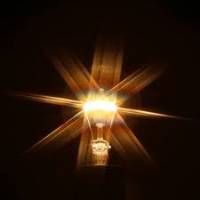Summary
This lesson is the second in the series of lessons, Wave Inventions. In this lesson students will make observations and conduct investigations to explore how light interacts with a variety of materials.
Essential Question(s)
How does light work when shined on different materials?
Snapshot
Engage
Students work as a class to make their classroom completely dark.
Explore
Students design an investigation to explore how light works with various materials.
Explain
After completing the investigation, students share what kind of material lets the least amount of light through.
Extend
Students apply their learning about light to understand how sunglasses work.
Evaluate
Students complete a Four Corners activity to explain the best material to use in various scenarios with light.
Materials
Flashlights
Tissue paper
Plastic wrap
Foil
Cardboard
Construction paper
Computer paper
Mirror
Sunglasses (Check with a local business or university to see if they have promotional glasses they would donate.)
Engage
As a class, try out and discuss the following challenge: How can we make this room completely dark?
Students will suggest things such as: close the doors, turn the lights off, turn off/cover monitors or equipment lights.
Students will also suggest covering windows. Cover windows by using the blinds, paper, sheer curtains, or something that still lets a little light through.
Ask students if the room is completely dark. Why isn’t it dark?
Responses might include:
There is still light coming through the window.
There are holes in the paper/curtain/blinds.
The light is too bright outside.
Cover the window with ____ instead.
Explore
Using the Four Corners strategy, ask students to predict which type of material (tissue paper, plastic wrap, foil, or construction paper) they think will be best to make the room completely dark.
Place the different materials in four corners around the room.
Ask students to go to the corner that contains the material that they think will make the room most completely dark.
Once students are in the corner they have chosen, ask them to have a conversation with others in that corner about why they made this prediction about the material and why the other materials might not work as well.
After the Four Corners activity, ask students to return to their seats. Explain that in their table groups (3-5 students), they will now create an investigation to figure out which material would work best to make the room completely dark. Students will use the Investigation Notes handout to design and conduct an investigation, trying out the different materials (tissue paper, plastic wrap, foil, construction paper) to find which one best prevents the light from shining. To set up their investigation, ask students to find a way to shine light on the different materials. Tell students they will need to make observations. Review the process for how to make observations safely. Ask students what they might expect to see in their observations. Tell students to wait to fill out the “Type of Material” column on the notes page.
Explain
After completing the investigation, students will repeat the Four Corners strategy, answering the same question "What material will be best to make the room completely dark?" Use the Think-Pair-Share strategy for students to explain why they chose that material.
Add to the students' descriptions and discussions using words such as reflective, opaque, transparent, and beams of light. Students will go back to the Investigation Notes handout and check which type of material each one is, based off the vocabulary above.
Extend
Take the students outside (sunny day preferred) and have them complete a compare and contrast activity of what the world looks like with and without sunglasses. Why would people wear sunglasses? What kind of material would be used to make sunglasses? What do sunglasses do to the light?
Evaluate
Using the Four Corners activity again, ask students to choose the best material (tissue paper, plastic wrap, foil, construction paper) for the following situations:
What material can we use to cover the window so no one can see in but allow some light to get through?
What material can we use to make out shapes/shadows but not see details when the light shines through?
What material can we use to cut out puppets and make a shadow play?
After each rotation, ask students to talk in their groups about why they chose their area. Then, ask a few students to share their thoughts with the class.
Resources
K20 Center. (n.d.). Four corners. Strategies. Retrieved from https://learn.k20center.ou.edu/strategy/d9908066f654727934df7bf4f5064550
K20 Center. (n.d.). Think-pair-share. Strategies. Retrieved from https://learn.k20center.ou.edu/strategy/d9908066f654727934df7bf4f5064b49


